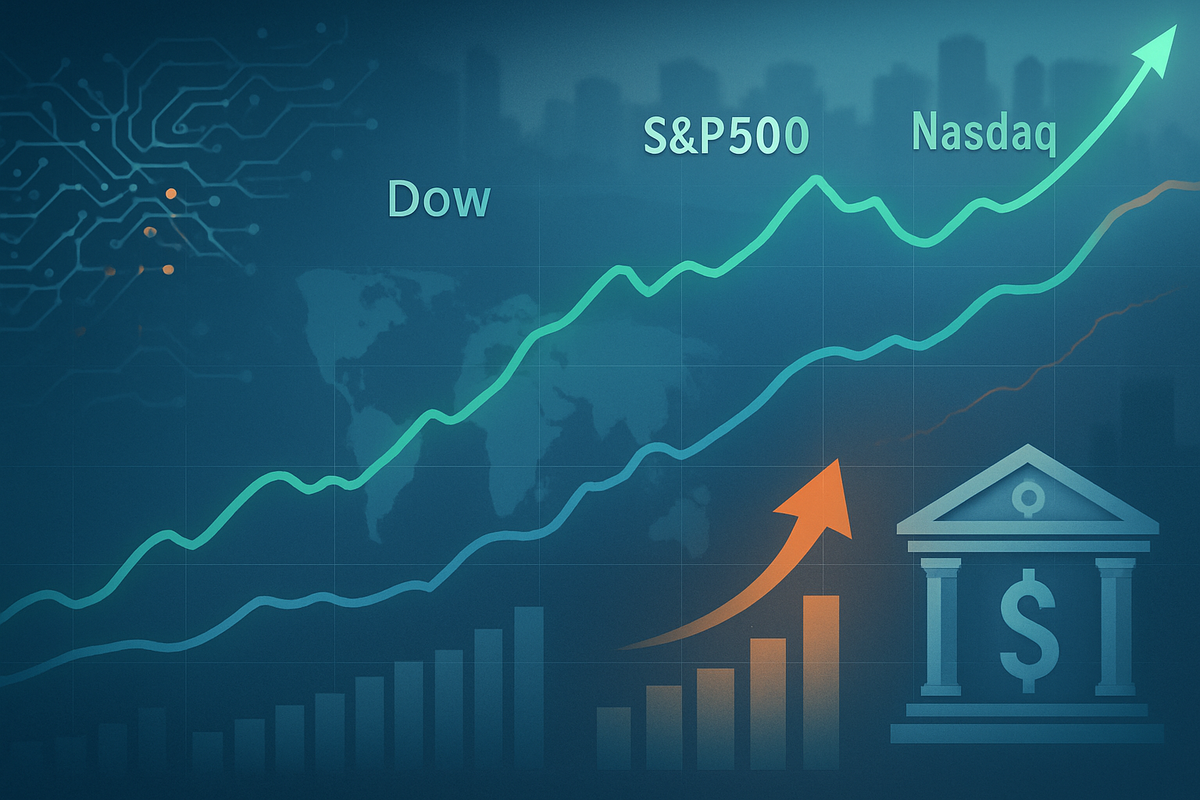
As of October 20, 2025, the U.S. stock market indices—the Dow Jones Industrial Average (DJIA), S&P 500, and Nasdaq Composite—are exhibiting a complex tapestry of performance, characterized by both robust gains and underlying volatility. While a significant rebound has been propelled by strong corporate earnings and strategic monetary policy, investors remain wary of persistent geopolitical tensions and evolving economic indicators. This dynamic environment suggests a market in a delicate balance, where optimism is tempered by caution.
The current landscape reflects a market attempting to consolidate recent gains while contending with a myriad of influencing factors. The tech-heavy Nasdaq Composite has notably outperformed its counterparts, signaling continued investor confidence in growth sectors, particularly those tied to artificial intelligence. However, broader market indices like the S&P 500 and Dow have also posted respectable year-to-date returns, indicating a more widespread, albeit uneven, economic recovery. The interplay of corporate profitability, Federal Reserve actions, and global events continues to shape the immediate trajectory of these bellwether indices.
Detailed Market Dynamics and Key Influencers
The period leading up to mid-October 2025 has seen a fascinating interplay of market forces. In the week ending October 17, 2025, the Nasdaq Composite led the charge, climbing 2.1%, while the S&P 500 advanced 1.7%, and the Dow Jones Industrial Average (DJIA) rose between 1.6% and 1.7%. These weekly gains underscore a resilient market, especially after a slight dip observed earlier in the week, where the DJIA recorded a minor fall on October 15, 2025, while the S&P 500 and Nasdaq continued their ascent.
Year-to-date figures paint an even clearer picture of robust growth. The Nasdaq Composite has delivered an impressive 16.9% return since January 1, 2025. The S&P 500 has also seen significant appreciation, returning +14.47% year-to-date and poised for a third consecutive year of double-digit returns. The Dow Jones Industrial Average (DJIA) has gained 8.7% for the year, showcasing a broad-based, albeit slower, upward trend. This performance is largely attributed to several key drivers.
A primary catalyst has been the exceptionally strong corporate earnings reports, particularly from the financial sector and AI-related mega-cap companies. Many financial institutions have exceeded projections, driven by growth in investment banking and trading activities. The "Magnificent 7" technology companies, in particular, are expected to post substantial earnings growth, further bolstering the Nasdaq's performance. Furthermore, the Federal Reserve's monetary policy has played a crucial role; a quarter-point rate cut in September, coupled with market expectations of another cut in October, has reduced borrowing costs and encouraged investment in risk assets.
Beyond earnings and monetary policy, robust consumer spending and significant corporate investments in artificial intelligence (AI) development have underpinned U.S. economic growth. Easing, albeit temporary, US-China trade tensions also provided a brief reprieve for markets, with President Trump confirming an upcoming meeting with Chinese President Xi Jinping. However, a softening labor market, with unemployment at 4.3% (up from 4% in January 2025), has also factored into the Fed's dovish stance, balancing growth with inflation concerns.
Corporate Winners and Losers in a Shifting Landscape
The current market dynamics create distinct opportunities and challenges for public companies across various sectors. The most prominent winners continue to be the "Magnificent 7" technology giants, which include companies like Apple (NASDAQ: AAPL), Microsoft (NASDAQ: MSFT), Alphabet (NASDAQ: GOOGL), Amazon (NASDAQ: AMZN), NVIDIA (NASDAQ: NVDA), Meta Platforms (NASDAQ: META), and Tesla (NASDAQ: TSLA). These companies, heavily invested in AI development and innovation, are experiencing substantial earnings growth and continue to attract significant investor capital, driving the Nasdaq's impressive performance. Their robust balance sheets and market dominance allow them to capitalize on the AI boom and navigate economic uncertainties more effectively.
The financial sector has also shown surprising strength, with many institutions reporting earnings that exceeded expectations. Companies such as JPMorgan Chase (NYSE: JPM) and Bank of America (NYSE: BAC) have benefited from increased investment banking activity and trading volumes, signaling a healthier banking environment despite some lingering concerns about regional banks. This resurgence in financial services contributes significantly to the S&P 500's overall positive trajectory.
Conversely, companies heavily reliant on traditional manufacturing or those facing intense competition without a clear AI integration strategy might struggle. While not explicitly detailed as "losers" in the research, the broader narrative suggests that sectors unable to adapt to technological advancements or those highly sensitive to inflation and interest rate fluctuations could face headwinds. Regional U.S. banks, for instance, continue to grapple with credit quality concerns, which could weigh on their individual performances even as the larger financial sector thrives. Furthermore, companies caught in the crosshairs of renewed US-China trade tensions could experience disruptions in supply chains and market access, impacting their profitability and investor sentiment.
The market's increasing concentration in a few mega-cap tech companies also presents a risk. While these companies are currently driving growth, their elevated valuations mean that any failure to meet lofty AI implementation expectations could lead to significant pullbacks, affecting not only these individual stocks but also potentially the broader indices given their substantial market capitalization within the S&P 500.
Wider Significance and Historical Context
The current performance of the major U.S. indices fits into several broader industry trends, most notably the escalating influence of artificial intelligence. AI is not merely a technological advancement but a transformative force reshaping industries, driving capital expenditures, and concentrating wealth in companies at the forefront of its development. This trend has led to a highly concentrated market, where a select group of AI-related mega-cap companies now constitute approximately 41% of the S&P 500's market capitalization. While this concentration fuels impressive index gains, it also raises questions about market breadth and sustainability, echoing historical periods where a few dominant companies disproportionately influenced market performance.
The ripple effects of these trends are far-reaching. Competitors in various sectors are compelled to accelerate their own AI integration strategies or risk falling behind. Partners, particularly those in the technology supply chain, stand to benefit from increased demand for components and services. However, the reliance on a few dominant players could also create vulnerabilities if these giants face regulatory scrutiny or significant operational setbacks. The banking sector, for example, while showing strong earnings from major players, still faces concerns about regional bank credit quality, a potential ripple effect from previous economic strains and rising interest rates.
Regulatory and policy implications are also significant. The Federal Reserve's recent rate cut and anticipated further easing underscore a policy pivot aimed at sustaining economic growth amidst a softening labor market and persistent, albeit moderating, inflation. The delayed release of U.S. Consumer Price Index (CPI) data due to a government shutdown highlights the impact of political stability on economic transparency and market sentiment. Historically, periods of government shutdowns have introduced uncertainty, affecting investor confidence and data-driven decision-making.
Comparing this period to historical precedents reveals similarities to other growth cycles driven by technological innovation, such as the dot-com boom of the late 1990s. While current market fundamentals appear stronger, the elevated valuations and market concentration in AI-related stocks warrant caution. The increased market volatility, as indicated by the CBOE VIX index hitting a nearly six-month high, is also a historical pattern observed during periods of economic transition and geopolitical uncertainty, such as renewed US-China trade tensions.
The Road Ahead: Navigating Future Possibilities
Looking ahead, the U.S. stock market faces a range of short-term and long-term possibilities, influenced by ongoing economic data, corporate earnings, and geopolitical developments. In the short term, the market's focus will remain squarely on upcoming Q3 earnings reports from major companies, including Netflix (NASDAQ: NFLX) and Tesla (NASDAQ: TSLA), which will provide crucial insights into corporate profitability and forward guidance. The delayed September CPI data, once released, will also be pivotal; if inflation exceeds expectations, the market may recalibrate its aggressive pricing of future Federal Reserve rate cuts, potentially introducing further volatility.
Long-term possibilities include a continued, albeit potentially more diversified, earnings growth beyond the current mega-cap tech leaders. Experts suggest that while AI will remain a powerful driver, its benefits could broaden to other sectors in 2026, leading to a more balanced market performance. Strategic pivots or adaptations will be crucial for companies that have not yet fully embraced AI or digital transformation. Those that can effectively integrate these technologies into their operations and business models will likely thrive, while laggards may face increasing competitive pressure.
Market opportunities may emerge in sectors that are currently undervalued but poised for growth as AI applications become more widespread. This could include certain industrial, healthcare, or consumer discretionary segments that successfully leverage AI for efficiency gains or new product development. Challenges will persist, particularly concerning the sustainability of current valuations for highly concentrated tech stocks and the ongoing geopolitical risks, such as renewed US-China trade tensions and potential instability in the regional banking sector.
Potential scenarios range from a "soft landing" where inflation gradually moderates, the Fed continues its easing cycle, and corporate earnings remain robust, leading to sustained market growth. Conversely, an "inflationary resurgence" could force the Fed to maintain higher rates or even reverse course, potentially triggering a market correction. Geopolitical escalations or a significant slowdown in global economic growth also pose downside risks. Investors should prepare for increased market dynamism and the need for agile portfolio management.
Comprehensive Wrap-up and Investor Outlook
In summary, the U.S. stock market, as of October 20, 2025, presents a landscape of cautious optimism, driven by strong corporate earnings—particularly from AI-centric tech giants and the financial sector—and supportive monetary policy from the Federal Reserve. The Nasdaq Composite has led the charge with impressive year-to-date gains, while the S&P 500 and Dow Jones Industrial Average have also delivered solid returns. However, this positive momentum is underscored by rising market volatility, concerns over market concentration in a few mega-cap companies, and persistent geopolitical and domestic economic risks, including renewed US-China trade tensions and regional banking stability.
Moving forward, the market's trajectory will be heavily influenced by upcoming corporate earnings reports, the Federal Reserve's future interest rate decisions, and the evolution of inflation data. The transformative power of artificial intelligence will continue to be a dominant theme, shaping investment opportunities and challenging companies to innovate and adapt. While the economic outlook remains cautiously optimistic, the increase in the CBOE VIX index suggests that investors should anticipate a period of heightened market fluctuations.
For investors, the key takeaways from this period are the importance of diversification and a discerning eye on valuations. While the allure of high-growth AI stocks is undeniable, experts recommend reviewing portfolios to ensure they are not overly concentrated in these areas. Considering non-U.S. equities and precious metals like gold can offer valuable diversification benefits in an increasingly uncertain global environment. Investors should closely watch for further developments in inflation, the Fed's policy statements, and the geopolitical arena in the coming months, as these will be critical determinants of market performance and stability.
This content is intended for informational purposes only and is not financial advice





